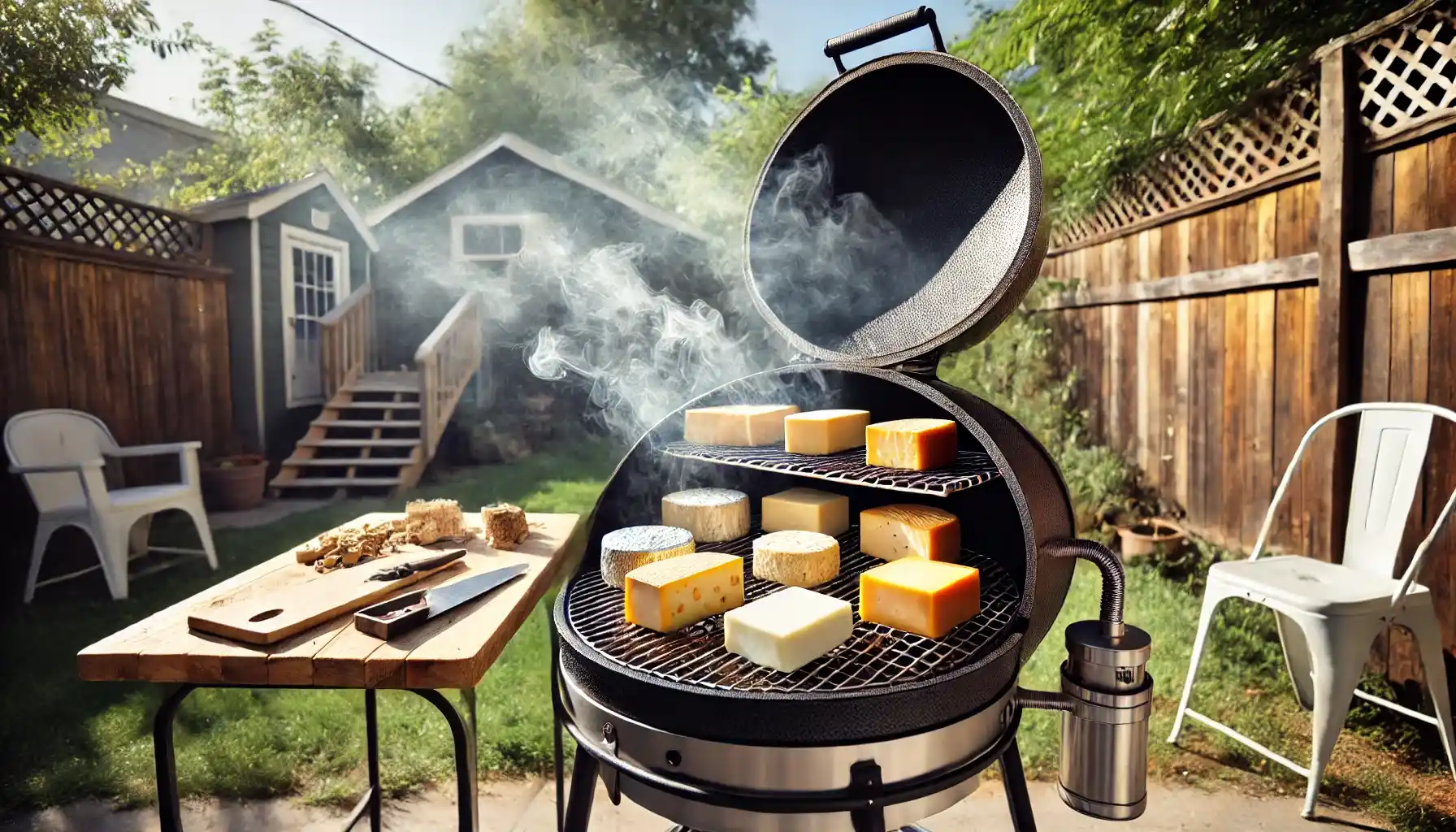Are you a cheese lover who wants to add a smoky twist to your favorite dairy delicacy? Look no further! This ultimate guide will walk you through the art of cold-smoking cheese on your grill. Cold smoking is a fantastic technique that infuses cheese with a delicate smoky flavor without melting it. Join us as we explore the tips and tricks from the pros to achieve mouthwatering results. Whether you’re a seasoned griller or a novice, this guide will equip you with the knowledge and skills to create the most delicious smoked cheese right in your own backyard.
What is Cold Smoking?
Cold smoking is a smoking technique that imparts a delightful smoky flavor to food without subjecting it to high temperatures. Unlike hot smoking, which cooks the food while smoking, cold smoking maintains a temperature range between 68°F and 86°F (20°C and 30°C). This allows the food, in our case cheese, to absorb the smoky essence without melting or becoming overcooked.
Choosing the Right Cheese
When it comes to cold-smoking cheese, not all varieties are created equal. Certain cheeses, especially hard or semi-hard ones, are better suited for cold smoking. These types have a firmer texture and can withstand smoking without losing shape. Cheddar, Gouda, Pepper Jack, and other similar cheeses work exceptionally well. Softer cheeses like cream cheese may be too delicate for cold smoking, but they can also be experimented with with some care.
Preparing Your Grill
Before you embark on your cold-smoking adventure, preparing your grill for the task at hand is essential. If you have a dedicated cold smoker, follow the manufacturer’s instructions to set it up. However, if you don’t own a cold smoker, fear not! You can still achieve excellent results by using your outdoor grill.
To prepare your grill, start by cleaning the grates thoroughly. Remove any residue from previous grilling sessions to ensure a clean smoking environment. Next, place a smoke tube or a smoke box filled with wood chips near the heat source. Wood pellets or wood chips specifically designed for smoking are great options. These will produce the desired smoke flavor during the cold smoking process.
Getting the Perfect Smoke
It’s important to strike the right balance between smoke and heat to achieve the best results. The goal is to generate enough smoke to flavor the cheese without raising the temperature inside the grill. The cheese may melt or lose shape if the grill gets too hot.
One effective technique combines a small amount of lit charcoal and unlit charcoal. The unit charcoal provides a steady heat source, while the lit charcoal creates the initial smoke. This method helps maintain a consistent temperature throughout the cold-smoking process.
Additionally, you can use a smoke chamber or generator to control the smoke produced. These devices ensure a continuous flow of smoke without needing to tend to the grill constantly.
The Cold Smoking Process
Now that you have everything set up, it’s time to dive into the cold-smoking process. Follow these steps to achieve perfectly smoked cheese:
Step 1: Preparing the Cheese
Start by selecting a block of cheese of your choice. It’s recommended to use pieces weighing around 1 to 2 pounds (450 to 900 grams) for optimal results. If necessary, grate the cheese or cut it into smaller blocks for easier handling during the smoking process.
Step 2: Setting Up Your Grill
Ensure that your grill is clean and ready for smoking. Place the cheese on the grill grates, ensuring enough space between the pieces for the smoke to circulate. Use a wire rack or place the cheese on top of parchment paper to prevent sticking.
Step 3: Cold Smoking the Cheese
Light the charcoal in your grill, either using a chimney starter or an electric starter and let it burn until the coals are covered in white ash. Once the coals are ready, place them on one side of the grill opposite the cheese.
Add a handful of wood chips or pellets to the lit charcoal, creating a small burst of smoke. This initial smoke will infuse the cheese with the desired flavor. Close the grill lid, ensuring the vents are partially open for proper airflow.
Step 4: Monitoring the Smoke
Throughout the cold-smoking process, monitoring the smoke levels and temperature inside the grill is important. You want a gentle stream of smoke, not billowing clouds. Adjust the vents on your grill accordingly to regulate the airflow and maintain the desired temperature range.
Step 5: Finishing and Storing the Smoked Cheese
After the recommended smoking time, typically 1 to 4 hours, depending on the desired intensity of smoke flavor, it’s time to remove the cheese from the grill. Carefully take the cheese off the grates and place it on a wire rack to cool. Let it rest at room temperature for about an hour to allow the smoke flavor to mellow.
Once cooled, you can choose to enjoy the smoked cheese right away, but for the best results, it’s recommended to let it rest in the refrigerator for at least 2 to 3 days. This resting period allows the flavors to develop and harmonize.
Troubleshooting Common Issues
While cold-smoking cheese is a relatively straightforward process, you may encounter some common issues along the way. Here are a few troubleshooting tips to help you overcome potential challenges:
Cheese melting: If the cheese starts to melt during the cold smoking process, it means the temperature inside the grill is too high. Adjust the airflow and reduce the heat source to bring the temperature down.
Lack of smoke flavor: If the cheese doesn’t possess enough smoke flavor, try increasing the smoking time or using stronger wood chips or pellets. Experiment with different types of wood to find the flavor profile you desire.
Bitter or acrid taste: A bitter or acrid taste can result from excessive smoke. Ensure that the smoke is not too dense and that the vents are properly adjusted for the right amount of airflow.
Safety Precautions
When engaging in grilling or smoking activities, it’s important to prioritize safety. Here are some safety precautions to keep in mind:
Fire safety: Never leave your grill unattended, especially when using charcoal or an open flame. Keep a fire extinguisher nearby and know how to use it in case of an emergency.
Proper ventilation: Ensure your grill is placed in a well-ventilated area, preferably outdoors. This helps prevent the accumulation of dangerous gases and smoke.
Food handling: Practice good hygiene and safety protocols when handling cheese or other food items. Wash your hands thoroughly and keep all utensils and surfaces clean.
Temperature control: Monitor the grill’s temperature and ensure it stays within the desired range. Avoid exposing the cheese to high temperatures that could lead to melting or spoilage.
By following these safety precautions, you can enjoy the cold smoking process while ensuring a safe and enjoyable experience.
Frequently Asked Questions
Can I cold-smoke cheese on a gas grill?
A: Yes, you can cold-smoke cheese on a gas grill. While gas grills are primarily designed for higher-heat cooking, a smoke box or tube can still achieve a cold-smoking environment. These accessories allow you to generate smoke while keeping the temperature inside the grill low. Follow the same steps outlined in this guide, adjusting the vents and maintaining the desired temperature range for cold smoking.
How long does it take to smoke cheese?
A: The smoking time for cheese can vary depending on several factors, including the desired intensity of smoke flavor and the type of cheese being smoked. As a general guideline, cold-smoking cheese typically takes between 1 to 4 hours. However, you can experiment with different smoking times to achieve your preferred level of smokiness. Keep in mind that longer smoking times will result in a stronger smoke flavor.
What are the best cheeses for smoking?
A: When it comes to cold-smoking cheese, the best options are hard or semi-hard cheeses that can withstand the smoking process without melting. Some popular choices include cheddar, Gouda, Swiss, provolone, and Pepper Jack. These cheeses have a firm texture that matches the smoky flavors. However, feel free to experiment with different cheese types to discover your favorites.
Should I vacuum seal the smoked cheese?
A: Vacuum-sealing smoked cheese can help prolong its shelf life and preserve its flavor. Once the cheese has rested in the refrigerator for the recommended time, you can vacuum seal it in individual portions or as a whole block. This prevents the cheese from absorbing any unwanted odors or flavors from the environment. Properly sealed smoked cheese can last for several weeks in the refrigerator.
How long can I store smoked cheese?
A: When stored correctly, smoked cheese can last for several weeks in the refrigerator. After the initial resting period of 2 to 3 days, you can wrap the smoked cheese tightly in plastic wrap or vacuum seal it to prevent air exposure. Keep the cheese in the coldest part of your refrigerator, ideally below 40°F (4°C). Before consuming the smoked cheese, remember to check for any signs of spoilage, such as mold or off odors.
We hope this ultimate guide has equipped you with the knowledge and confidence to cold-smoke cheese on your grill. Enjoy the process, experiment with different flavors, and savor the delicious results of your smoking endeavors. Happy grilling!
Ameer Hamza Mughal is a content writer specializing in creating delicious and easy-to-follow recipes. He is passionate about sharing his culinary knowledge and helping others explore the joy of cooking. With a focus on clear instructions and mouthwatering descriptions, Ameer’s recipes are sure to inspire you to create delectable dishes in your own kitchen.

